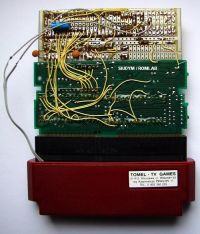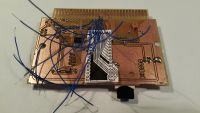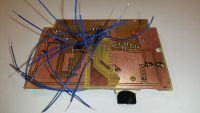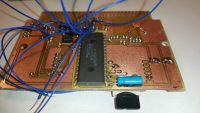Thanks for the nice words and constructive comments.
@gulson -> Not so long ago I was ordering gadgets and I would not like to stretch the electrode budget. For me, the biggest motivation to share knowledge is that the electrode forum brings together a lot of people with similar skills and interests, each one will write a more or less constructive comment, which stimulates further work and development. And not like writing articles for commercial magazines, where you get some cash, but there is hardly any feedback.
@andrzejlisek -> all 168 games work. I don't know why Contra emulator doesn't work. Yes, that's right - the mapper 15 that was assigned for the purposes of emulating this game is not 100% compatible with what is in this cartridge. Urban Champion has a few letters slightly smeared on the title set because this game has a ROM as a graphics memory and for some unknown reasons it tries to write something to it. As in map 15 the compilation has RAM memory, write attempts are accepted and hence a few letters are erased. The integrated circuit in 168-in-1, on the other hand, blocks the writing to this memory immediately after selecting the game. For me it is not blocked, so these few letters are blurred, but this is the game's fault.
And don't VS games have their counterparts in the console version? Besides, there are probably only 15 of these games.
As for some comments:
unattractive name - maybe I am not a marketing specialist, I call my products after my name. And whether it is a funny or cool name, it depends on your taste. Somehow no one is surprised that the most popular brands are after all. micro-soft, apple, windows.
no RAM memory protection for games that allow saving -> such games can be counted on the fingers of one or two hands at the most. In addition, starting another game that also saves something to memory causes the previous save to be blurred. Unless you save it to the card before starting it - a lot of additional work, and probably some memory support controller after a power failure. Many mappers offered something like RAM write protection - contrary to appearances, this is not to accidentally overwrite bytes, but it just protects against the fact that when the consoles are turned off at an unexpected moment, the data from RAM memory, despite being powered by a battery, will not disappear - the game sets the protection most of the time, disables it only for a moment for the duration of the save itself. The point is that when switching from the +5 V power supply to the 3 V battery power supply, the memory line! CS should be high.
the inability to save the game at any time -> the whole pleasure of playing is probably just to focus on the game, and not return to the state before saving after every temptation? Otherwise, it's actually better to choose an emulator. From the technical side, it is also troublesome - the need to dump not only the RAM content, but also the processor's state (battery and other registers, flags, registers responsible for sound), GPU state, mapper state
the whole project makes no sense - you can buy itfor + PLN 100 raspberry / nintendo wii or other - well, I won't argue here anymore. It is a bit as if someone on the toddlers' automotive forum boasted a super-restored Fiat, and the other started calling him sheep, because for this money he could buy a golf with 5 times more powerful engine.
High price -> the price is not only the cost of components, but also the time of PCB production, soldering, testing and some compensation for the time spent on working on the development of the cartridge. Here it is also a bit as if someone entered a restaurant and started criticizing that dinner was too expensive, because I will buy pork chop in a ladybug for PLN 5, a kilo of potatoes for PLN 1.5 ...
recording card games is pirates -> yes, as well as playing the same games under the emulator - I do not urge. Few people know that the 168-in-1, gold 5, gold 4 and 99% yellow and other pegasus cartridges known from childhood are also pirates. In fact, all Pegasus cartridges are pirates, because it's an unofficial console. The only original ones are the angular Famicom cartridges (only those are suitable for the Pegasus) and the gray ones for the NESA. Among the NES cartridges, many companies (Codemasters, Konami?) Also released games outside of the Nintendo license. The NES console has a CIC chip that protects against unauthorized cartridge. Authorized games have the same layout, so their communication is smooth and the console is not restarted. These labels had to somehow get around the CIC protection in the console - they usually generated short negative voltage pins that led to a latch-up (hang) in the console's CIC that kept the game running.
But as I mentioned, there are a lot of homebrew production games, and the cartridge was also meant to be a test platform for developers of their own games.
the ability to quickly return to a previously loaded game after turning off the console without having to search for that game again -> valuable note. The card has the ability to update the software, so it will probably be added soon (we upload a newer version to the micro SD memory card and select the file, the update occurs automatically). This will speed up the return to the game a bit, but for many games, the content of the memory with graphics will have to be re-loaded (there is RAM on the cartridge that loses its content when the power is cut off)
Sometimes, however, I am surprised by 100% hate-oriented comments. Well, it would be hard for Copernicus or Einstein to live today. Probably he would have to leave his discovery only to himself and take it to the grave in order not to be ridiculed.
Such a little joke to improve the mood:
Quote:
Lucifer in Hell is inspecting. He goes to the first cauldron that is guarded by 10 Devils and asks:
-why as many as 10 devils guard this cauldron?
-because the Americans are boiling in this boiler, they are ambitious and everyone is trying to jump out every now and then
Lucifer goes on and notices the cauldron with 5 devils next to it. He comes up and asks:
- are only 5 devils enough here?
-yes, the English are boiling in the boiler, they are ambitious, but a bit phlegmatic at the same time, so 5 is enough
Then lucifer approaches the cauldron with one devil standing by and asks him a question:
-Is you alone here to look after the boiler?
-Yes, because the Germans are boiling in the boiler, they are a disciplined nation, so one devil is enough
As Lucifer walks on, he notices a cauldron that no one is guarding. He goes and looks for some devil to explain the situation to him, until he finally finds a devil resting somewhere, so he comes up and asks:
-why nobody is watching this boiler?
-because there are Poles in it
-Do these people not want to get out of this boiler?
- if they want to, only when one tries to get out and climbs the wall, the rest grabs him and pulls him back down.















